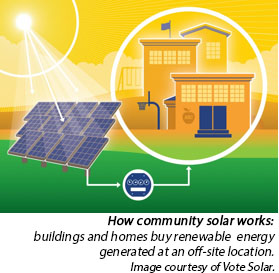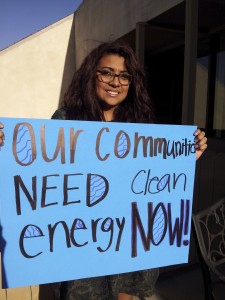September 8, 2014
Heather Lewis, Attorney, CBE Legal Fellow*
Last year, CEJA and our members worked hard to win a program that could bring clean, renewable energy to California’s most vulnerable and polluted neighborhoods. This fall, the California Public Utilities Commission (CPUC) will be making decisions on how the program will be structured and we will be fighting to make sure they uphold the commitment to environmental justice communities!
Join CEJA this Thursday to support of renewable energy for the communities most impacted by dirty fossil fuels!
Time & place: 9:30 am, CPUC, 505 Van Ness Ave, SF
Contact Strela Cervas for more information: scervas [at] caleja.org
What are shared renewable programs and how can they help our communities?
Low-income communities and communities of color are disproportionately impacted by dirty energy production, but rarely see the benefits of clean energy development. In 2013, the California legislature took a major step in overcoming this green divide with Senate Bill (SB) 43. SB 43 requires the State’s three major utilities—Pacific Gas & Electric in the Bay Area, San Diego Gas & Electric in San Diego, and Southern California Edison in the Los Angeles area—to enact “Green Tariff Shared Renewable Programs” that make renewable energy accessible to customers who would not otherwise be able to purchase electricity from renewable sources—renters who cannot install rooftop solar, or individuals with low credit scores who do not qualify for renewable installations, for example. SB 43 also requires that one-sixth of the program capacity (100 MW out of 600 MW total) be reserved for projects in the state’s most impacted and disadvantaged communities.
 Importantly, SB 43 requires the utilities to provide support for community renewables programs. Community or shared renewables arrangements allow multiple customers to share the benefits of a local renewable generation facility. Community renewables provide a solution for those individuals who cannot otherwise access renewable energy, allowing communities to pool resources and share in the output from one project. For California’s most polluted and vulnerable communities, which have historically been denied a voice in the decisionmaking processes that determine where polluting power plants are located, community renewables finally provide an opportunity to participate in, and benefit from, the siting of renewable energy.
Importantly, SB 43 requires the utilities to provide support for community renewables programs. Community or shared renewables arrangements allow multiple customers to share the benefits of a local renewable generation facility. Community renewables provide a solution for those individuals who cannot otherwise access renewable energy, allowing communities to pool resources and share in the output from one project. For California’s most polluted and vulnerable communities, which have historically been denied a voice in the decisionmaking processes that determine where polluting power plants are located, community renewables finally provide an opportunity to participate in, and benefit from, the siting of renewable energy.
The CPUC is currently evaluating the three utilities’ program proposals, and is expected to decide on the proposal in October. These proposals have been the subject of extensive hearings and testimony at the CPUC. We have been involved throughout the proceeding to ensure that the concerns of environmental justice communities are heard, but unfortunately, we believe that some of the utility proposals do not do enough to ensure that these benefits to our communities are realized.
Join us this Thursday, September 11 at the CPUC Meeting (9:30am at 505 Van Ness Ave. in San Francisco) to speak out in support of renewable energy for the communities most impacted by dirty fossil fuels. We will continue our pressure throughout September and October, so stay tuned for more news and ways to support the effort!
Contact Strela Cervas for more information: scervas [at] caleja.org
*This post was written for the California Environmental Justice Alliance. See more at: http://caleja.org/ and http://caleja.org/2014/09/making-sure-ej-communities-get-their-share-of-shared-renewables/



